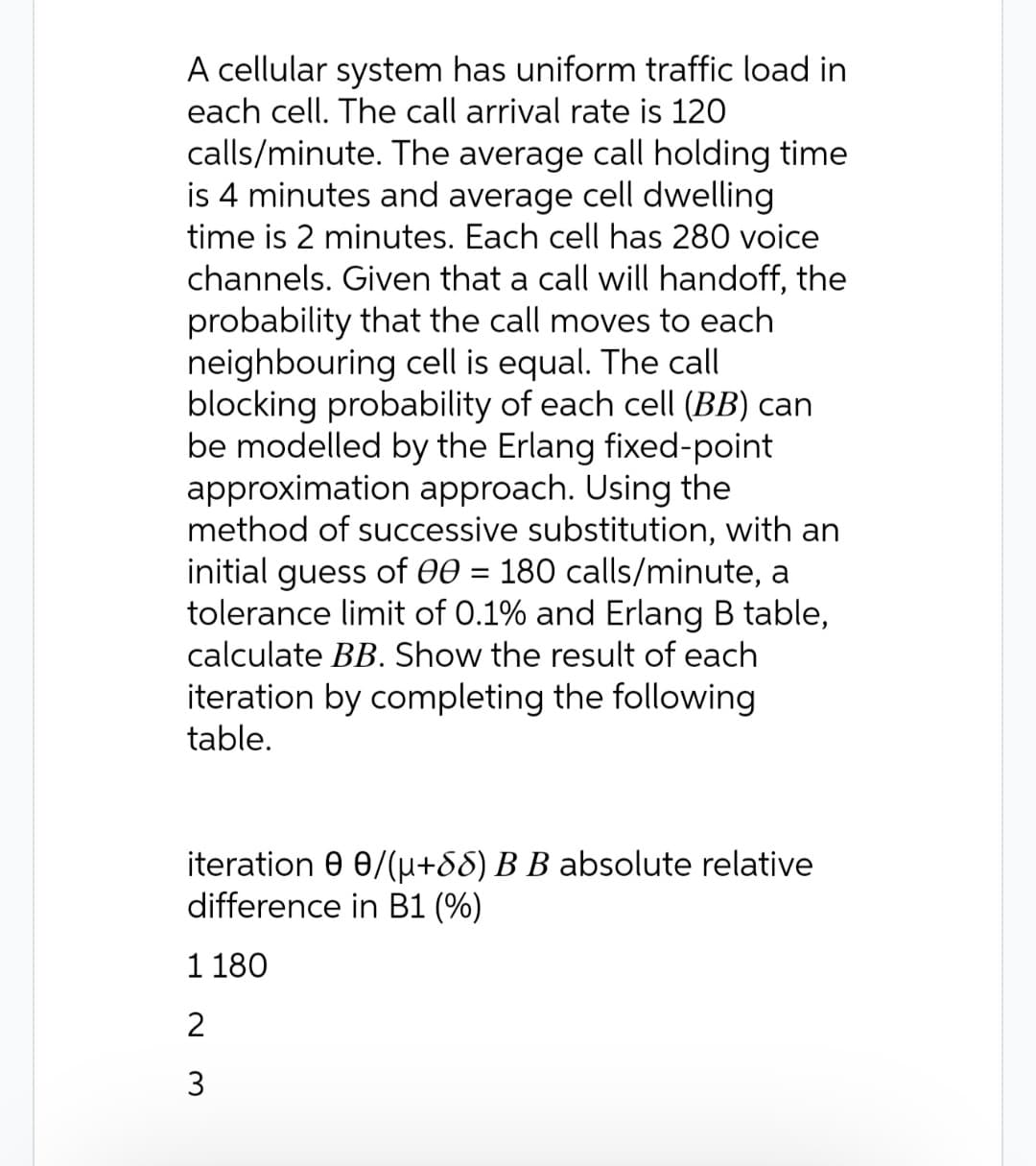A cellular system has uniform traffic load in each cell. The call arrival rate is 120 calls/minute. The average call holding time is 4 minutes and average cell dwelling time is 2 minutes. Each cell has 280 voice channels. Given that a call will handoff, the probability that the call moves to each neighbouring cell is equal. The call
A cellular system has uniform traffic load in each cell. The call arrival rate is 120 calls/minute. The average call holding time is 4 minutes and average cell dwelling time is 2 minutes. Each cell has 280 voice channels. Given that a call will handoff, the probability that the call moves to each neighbouring cell is equal. The call
Computer Networking: A Top-Down Approach (7th Edition)
7th Edition
ISBN:9780133594140
Author:James Kurose, Keith Ross
Publisher:James Kurose, Keith Ross
Chapter1: Computer Networks And The Internet
Section: Chapter Questions
Problem R1RQ: What is the difference between a host and an end system? List several different types of end...
Related questions
Question

Transcribed Image Text:A cellular system has uniform traffic load in
each cell. The call arrival rate is 120
calls/minute. The average call holding time
is 4 minutes and average cell dwelling
time is 2 minutes. Each cell has 280 voice
channels. Given that a call will handoff, the
probability that the call moves to each
neighbouring cell is equal. The call
blocking probability of each cell (BB) can
be modelled by the Erlang fixed-point
approximation approach. Using the
method of successive substitution, with an
initial guess of 00 = 180 calls/minute, a
tolerance limit of 0.1% and Erlang B table,
calculate BB. Show the result of each
iteration by completing the following
table.
iteration 0 0/(μ+88) B B absolute relative
difference in B1 (%)
1 180
2
3
Expert Solution
This question has been solved!
Explore an expertly crafted, step-by-step solution for a thorough understanding of key concepts.
Step by step
Solved in 2 steps with 2 images

Recommended textbooks for you

Computer Networking: A Top-Down Approach (7th Edi…
Computer Engineering
ISBN:
9780133594140
Author:
James Kurose, Keith Ross
Publisher:
PEARSON

Computer Organization and Design MIPS Edition, Fi…
Computer Engineering
ISBN:
9780124077263
Author:
David A. Patterson, John L. Hennessy
Publisher:
Elsevier Science

Network+ Guide to Networks (MindTap Course List)
Computer Engineering
ISBN:
9781337569330
Author:
Jill West, Tamara Dean, Jean Andrews
Publisher:
Cengage Learning

Computer Networking: A Top-Down Approach (7th Edi…
Computer Engineering
ISBN:
9780133594140
Author:
James Kurose, Keith Ross
Publisher:
PEARSON

Computer Organization and Design MIPS Edition, Fi…
Computer Engineering
ISBN:
9780124077263
Author:
David A. Patterson, John L. Hennessy
Publisher:
Elsevier Science

Network+ Guide to Networks (MindTap Course List)
Computer Engineering
ISBN:
9781337569330
Author:
Jill West, Tamara Dean, Jean Andrews
Publisher:
Cengage Learning

Concepts of Database Management
Computer Engineering
ISBN:
9781337093422
Author:
Joy L. Starks, Philip J. Pratt, Mary Z. Last
Publisher:
Cengage Learning

Prelude to Programming
Computer Engineering
ISBN:
9780133750423
Author:
VENIT, Stewart
Publisher:
Pearson Education

Sc Business Data Communications and Networking, T…
Computer Engineering
ISBN:
9781119368830
Author:
FITZGERALD
Publisher:
WILEY